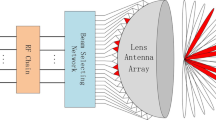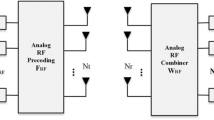Abstract
Extremely large-scale multiple-input-multiple-output (XL-MIMO) at millimeter-wave (mmWave) and terahertz (THz) bands plays an important role in supporting extreme high beamforming gain as well as ultra-wideband spectrum resources. Unfortunately, accurate wideband XL-MIMO channel estimation suffers from a new challenge called the near-field beam split effect. Prior studies either neglect the accurate near-field channel model or fail to exploit the beam split effect, resulting in poor channel estimation accuracy for wideband XL-MIMO. To tackle this problem, this paper proposes a bilinear pattern detection (BPD)-based approach to accurately recover the wideband XL-MIMO channel. Specifically, by analyzing the characteristics of near-field wideband channels, we first reveal the bilinear pattern of the near-field beam split effect, which implies that the sparse support set of near-field channels in both the angle and the distance domains can be regarded as a linear function against frequency. Then, inspired by the classical simultaneously orthogonal matching pursuit technique, we use the bilinear pattern to estimate the angle-of-arrival (AoA) and distance parameters of each near-field path component at all frequencies. In this way, the entire wideband XL-MIMO channel can be recovered by compressed sensing algorithms. Moreover, we provide the computational complexity of the proposed algorithm compared with existing algorithms. Finally, simulation results demonstrate that our scheme can achieve the accurate estimation of the near-field wideband XL-MIMO channel in the presence of near-field beam split effect.
Similar content being viewed by others
References
Rappaport T S, Xing Y, Kanhere O, et al. Wireless communications and applications above 100 GHz: opportunities and challenges for 6G and beyond. IEEE Access, 2019, 7: 78729–78757
Zhang Z, Xiao Y, Ma Z, et al. 6G wireless networks: vision, requirements, architecture, and key technologies. IEEE Veh Technol Mag, 2019, 14: 28–41
Ning B, Tian Z, Chen Z, et al. Prospective beamforming technologies for ultra-massive MIMO in terahertz communications: a tutorial. 2021. ArXiv:2107.03032
Lin C, Li G Y L. Terahertz communications: an array-of-subarrays solution. IEEE Commun Mag, 2016, 54: 124–131
Akdeniz M R, Liu Y, Samimi M K, et al. Millimeter wave channel modeling and cellular capacity evaluation. IEEE J Sel Areas Commun, 2014, 32: 1164–1179
Akyildiz I F, Han C, Nie S. Combating the distance problem in the millimeter wave and terahertz frequency bands. IEEE Commun Mag, 2018, 56: 102–108
Akyildiz I F, Jornet J M, Han C. Terahertz band: next frontier for wireless communications. Phys Commun, 2014, 12: 16–32
Sohrabi F, Yu W. Hybrid digital and analog beamforming design for large-scale antenna arrays. IEEE J Sel Top Signal Process, 2016, 10: 501–513
Heath R W, Gonzalez-Prelcic N, Rangan S, et al. An overview of signal processing techniques for millimeter wave MIMO systems. IEEE J Sel Top Signal Process, 2016, 10: 436–453
Lee J, Gil G T, Lee Y H. Channel estimation via orthogonal matching pursuit for hybrid MIMO systems in millimeter wave communications. IEEE Trans Commun, 2016, 64: 2370–2386
Huang C, Liu L, Yuen C, et al. Iterative channel estimation using LSE and sparse message passing for mmWave MIMO systems. IEEE Trans Signal Process, 2019, 67: 245–259
Rodriguez-Fernandez J, Gonzalez-Prelcic N, Venugopal K, et al. Frequency-domain compressive channel estimation for frequency-selective hybrid millimeter wave MIMO systems. IEEE Trans Wireless Commun, 2018, 17: 2946–2960
Gao Z, Hu C, Dai L, et al. Channel estimation for millimeter-wave massive MIMO with hybrid precoding over frequency-selective fading channels. IEEE Commun Lett, 2016, 20: 1259–1262
Eldar Y C. Sampling Theory: Beyond Bandlimited Systems. Cambridge: Cambridge University Press, 2015
Liao A, Gao Z, Wang D, et al. Terahertz ultra-massive MIMO-based aeronautical communications in space-air-ground integrated networks. IEEE J Sel Areas Commun, 2021, 39: 1741–1767
Tan J, Dai L. Wideband channel estimation for THz massive MIMO. China Commun, 2021, 18: 66–80
Dovelos K, Matthaiou M, Ngo H Q, et al. Channel estimation and hybrid combining for wideband terahertz massive MIMO systems. IEEE J Sel Areas Commun, 2021, 39: 1604–1620
Yang J, Zeng Y, Jin S, et al. Communication and localization with extremely large lens antenna array. IEEE Trans Wireless Commun, 2021, 20: 3031–3048
Chen Y, Yan L, Han C. Hybrid spherical- and planar-wave modeling and DCNN-powered estimation of terahertz ultra-massive MIMO channels. IEEE Trans Commun, 2021, 69: 7063–7076
Cui M, Dai L. Channel estimation for extremely large-scale MIMO: far-field or near-field? IEEE Trans Commun, 2022, 70: 2663–2677
Cui M, Wu Z, Lu Y, et al. Near-field MIMO communications for 6G: fundamentals, challenges, potentials, and future directions. IEEE Commun Mag, 2023, 61: 40–46
Selvan K T, Janaswamy R. Fraunhofer and fresnel distances: unified derivation for aperture antennas. IEEE Antennas Propag Mag, 2017, 59: 12–15
Zhang H, Shlezinger N, Guidi F, et al. Beam focusing for near-field multiuser MIMO communications. IEEE Trans Wireless Commun, 2022, 21: 7476–7490
Cui M, Dai L, Wang Z, et al. Near-field rainbow: wideband beam training for XL-MIMO. IEEE Trans Wireless Commun, 2022. doi: https://doi.org/10.1109/TWC.2022.3222198
Zhou Z, Gao X, Fang J, et al. Spherical wave channel and analysis for large linear array in LoS conditions. In: Proceedings IEEE Globecom Workshops, San Diego, 2015
Wei L, Huang C, Alexandropoulos G C, et al. Channel estimation for RIS-empowered multi-user MISO wireless communications. IEEE Trans Commun, 2021, 69: 4144–4157
Zhang Z, Dai L. A joint precoding framework for wideband reconfigurable intelligent surface-aided cell-free network. IEEE Trans Signal Process, 2021, 69: 4085–4101
Acknowledgements
This work was supported in part by National Natural Science Foundation of China (Grant No. 62031019), National Key Research and Development Program of China (Grant No. 2020YFB1805005), and European Commission through the H2020-MSCA-ITN META WIRELESS Research Project (Grant No. 956256).
Author information
Authors and Affiliations
Corresponding author
Rights and permissions
About this article
Cite this article
Cui, M., Dai, L. Near-field wideband channel estimation for extremely large-scale MIMO. Sci. China Inf. Sci. 66, 172303 (2023). https://doi.org/10.1007/s11432-022-3654-y
Received:
Revised:
Accepted:
Published:
DOI: https://doi.org/10.1007/s11432-022-3654-y




